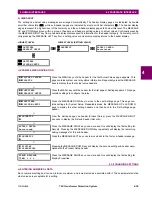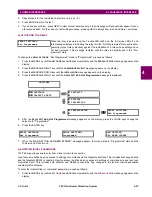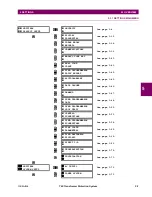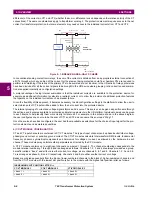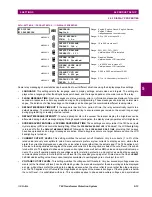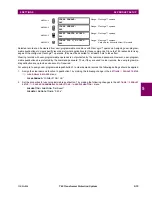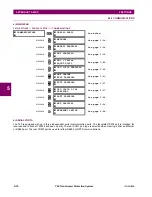
GE Multilin
T60 Transformer Protection System
5-5
5 SETTINGS
5.1 OVERVIEW
5
(EQ 5.2)
Many settings are common to most elements and are discussed below:
•
FUNCTION setting:
This setting programs the element to be operational when selected as “Enabled”. The factory
default is “Disabled”. Once programmed to “Enabled”, any element associated with the function becomes active and all
options become available.
•
NAME setting:
This setting is used to uniquely identify the element.
•
SOURCE setting:
This setting is used to select the AC source to be monitored. See the Introduction to AC Sources
section later.
•
PICKUP setting:
For simple elements, this setting is used to program the level of the measured parameter above or
below which the pickup state is established. In more complex elements, a set of settings may be provided to define the
range of the measured parameters which will cause the element to pickup.
•
PICKUP DELAY setting:
This setting sets a time-delay-on-pickup, or on-delay, for the duration between the pickup
and operate output states.
•
RESET DELAY setting:
This setting is used to set a time-delay-on-dropout, or off-delay, for the duration between the
Operate output state and the return to logic 0 after the input transits outside the defined pickup range.
•
BLOCK setting:
The default output operand state of all comparators is a logic 0 or “flag not set”. The comparator
remains in this default state until a logic 1 is asserted at the RUN input, allowing the test to be performed. If the RUN
input changes to logic 0 at any time, the comparator returns to the default state. The RUN input is used to supervise
the comparator. The BLOCK input is used as one of the inputs to RUN control.
•
TARGET setting:
This setting is used to define the operation of an element target message. When set to
“
Disabled
”
,
no target message or illumination of a faceplate LED indicator is issued upon operation of the element. When set to
“Self-Reset”, the target message and LED indication follow the operate state of the element, and self-resets once the
operate element condition clears. When set to “Latched”, the target message and LED indication will remain visible
after the element output returns to logic 0 until a RESET command is received by the relay.
•
EVENTS setting:
This setting is used to control whether the pickup, dropout or operate states are recorded by the
event recorder. When set to “Disabled”, element pickup, dropout or operate are not recorded as events. When set to
“Enabled”, events are created for:
(Element) PKP (pickup)
(Element) DPO (dropout)
(Element) OP (operate)
The DPO event is created when the measure and decide comparator output transits from the pickup state (logic 1) to
the dropout state (logic 0). This could happen when the element is in the operate state if the reset delay time is not 0.
Not every operand of a given element in a UR relay generates events, only the major output operands. Elements,
asserting output per phase, log operating phase output only, without asserting the common three-phase operand
event.
5.1.3 INTRODUCTION TO AC SOURCES
a) BACKGROUND
A mechanism called a
source
configures the routing of CT and VT input channels to measurement sub-systems. Sources,
in the context of UR series relays, refer to the logical grouping of current and voltage signals such that one source contains
all the signals required to measure the load or fault in a particular power apparatus. A given source may contain all or some
of the following signals: three-phase currents, single-phase ground current, three-phase voltages and an auxiliary voltage
from a single VT for checking for synchronism.
The basic idea of an AC source is to select a point on the power system where the voltages and currents are of interest. To
illustrate the concept of sources, as applied to current inputs only, consider the breaker-and-a-half scheme below. In this
application, the current flows as shown by the arrows. Some current flows through the upper bus bar to some other location
or power equipment, and some current flows into transformer winding 1. The current into winding 1 is the phasor sum (or
13800
14400
----------------
120
3
----------
×
66.4 V
=
Summary of Contents for UR T60
Page 10: ...x T60 Transformer Protection System GE Multilin TABLE OF CONTENTS ...
Page 14: ...xiv T60 Transformer Protection System GE Multilin 0 1 BATTERY DISPOSAL 0 BATTERY DISPOSAL 0 ...
Page 34: ...1 20 T60 Transformer Protection System GE Multilin 1 5 USING THE RELAY 1 GETTING STARTED 1 ...
Page 436: ...5 298 T60 Transformer Protection System GE Multilin 5 10 TESTING 5 SETTINGS 5 ...
Page 678: ...C 30 T60 Transformer Protection System GE Multilin C 7 LOGICAL NODES APPENDIX C C ...
Page 688: ...D 10 T60 Transformer Protection System GE Multilin D 1 IEC 60870 5 104 PROTOCOL APPENDIX D D ...
Page 700: ...E 12 T60 Transformer Protection System GE Multilin E 2 DNP POINT LISTS APPENDIX E E ...







